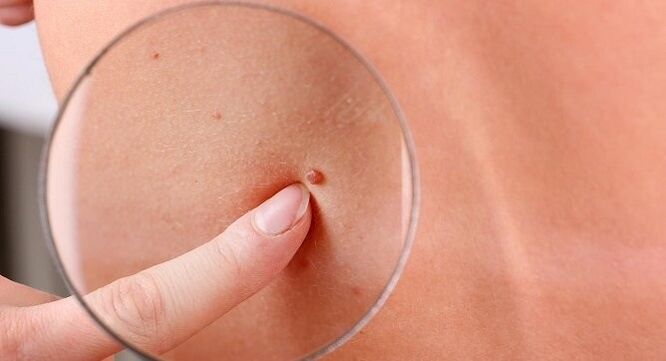Papillomas on the body are benign tumors of an infectious nature. Predominantly 16 and 18 strains have a tendency to degenerate into malignant forms (more than 100 species are known in total). Wart and papilloma are synonymous.
Characteristics of the disease:
- It occurs in people of all ages, mainly in women (the number of detected cases is 1. 5 times higher than in men).
- Infection occurs through household contact or sexual contact. It goes unnoticed for a long time because the virus does not have a strong effect on the immune system. In addition, after the introduction into the genome, only the viral DNA remains, not the virus itself (it is almost impossible to remove).
- There are a number of vaccines designed to reduce infections and reduce susceptibility to the viral agent.
- Immunity after infection is type-specific, non-cross, non-stressed, low, which means the possibility of re-infection.

Reasons
The main cause of papilloma on the body is the human papilloma virus (HPV, papilloma virus). It belongs to the DNA-containing viruses, which explains its ability to integrate into the human genome and change its structure. The virus enters the bloodstream through microdamages and settles on the basal layer of the epidermis. The division takes place only at the level of the germ leaf, in the others the virus can be detected, but at these levels there is no division.
There are several clinical forms of the disease:
- manifest - primary virus infection in people with reduced immunity;
- subclinical - a form in which periodically appear manifestations of this pathology, followed by prolonged relapses;
- latent - a form associated with the direct integration of the virus into the genome (carrying).
Predisposing factors for the development of neoplasms:
- Skin damage. The virus is unable to enter the bloodstream without at least minimal damage to the skin, which serves as a gateway to infection.
- Decreased immunity. HPV can be attributed to opportunistic viruses, making it dangerous to humans in the event of suppression of a normal cellular or humoral immune response.
- Failure to comply with hygiene rules when visiting public places. The virus is contagious and infection can occur even at low concentrations in the environment.
- Disruption of the normal diet, constant stress and lack of proper rest lead to suppression of the immune system, the body becomes vulnerable to the action of the pathogen.
- Frequent inflammatory and infectious diseases lead to depletion of the immune system (this is especially important for people who are often ill).
- Human papillomavirus can also be transmitted from mother to child at birth (vertical transmission).
External manifestations
The external manifestations of papillomas in the photo have the following characteristics:
- Numerous formations protruding above the surface of the skin. They can be in the form of a classic wart (flat lesion on a wide stalk) or have a thin stalk and hang over the skin like a rooster's comb.
- The color rarely differs from the surrounding tissues. Exceptions are cases of germination of the formation in the superficial vascular network, in which case it acquires a reddish tinge. A rapid change in color signals possible rebirth (differentiation with moles is also performed).
- The contour is usually smooth and clear. Exceptions are formations that have degenerated into a tumor.
- The surface is often smooth and somewhat shiny. In the case of localization in the area of the upper eyelids, neck, armpits, the surface is often uneven with pointed elevations such as cauliflower.
- The diameter varies from small foci from a few millimeters to 1-2 cm. On the same part of the human body may be present formations of different calibers. If the papilloma grows too fast, consult a doctor.
How to get rid of papillomas
The treatment of papillomas on the body is performed according to a single scheme, regardless of the exact location (for each specific type there is an optimal option or combination):
- Destructive methods (physical and chemical).
- Combined techniques (simultaneous action of local drugs and destructive treatment options).
It is permissible to treat papillomas with cytotoxic and immunological preparations only in the complete process (papillomatosis, ie a very large number of papillomas on the body). In cases of single lesions, such therapy is not performed due to the large number of side effects and cross-reactions with drugs from these groups.
Methods of destruction
The possibilities for destructive treatment are the same for all types of skin lesions caused by HPV. They are divided into physical and chemical.
Methods of physical destruction:
> zxtable border = "1" cellpadding = "0" >Folk remedies
At home it is permissible to get rid of growth with traditional medicine, but it should be borne in mind that their effectiveness is low. In addition, before starting such treatment, it is necessary to consult a specialist to distinguish papillomas from a number of other skin diseases with similar manifestations.
> zxtable border = "1" cellpadding = "0" >Crush a few flowers in a mortar, apply the resulting mixture on the affected area and fix for 30 minutes. Repeat the procedure in the morning and evening for 21 days.























